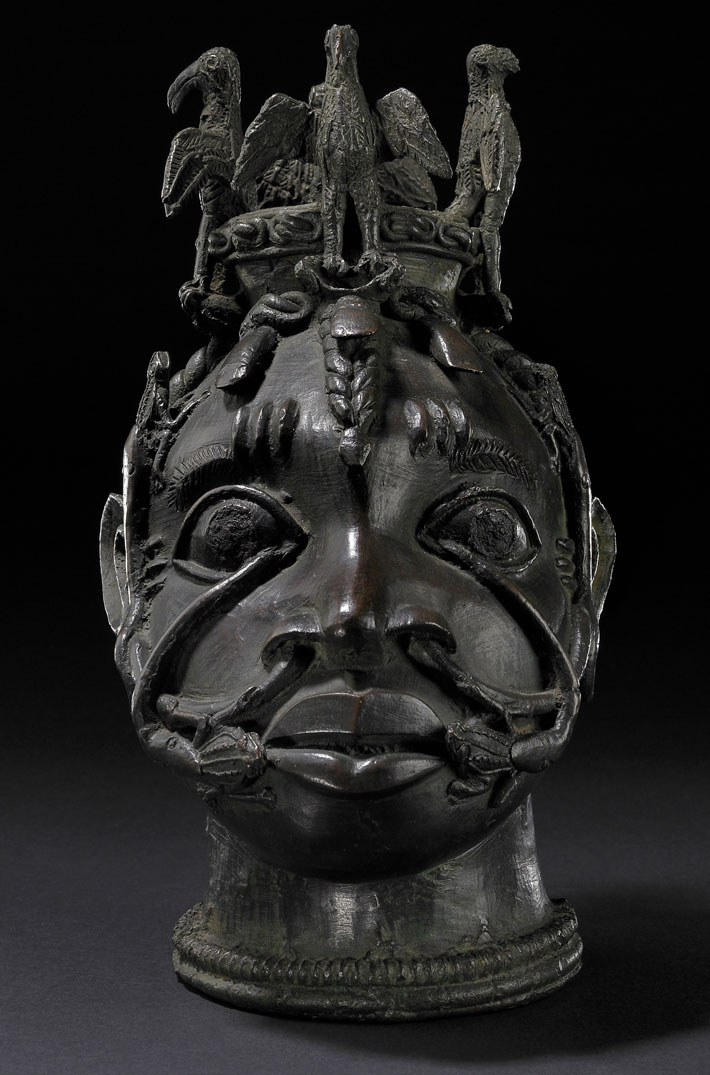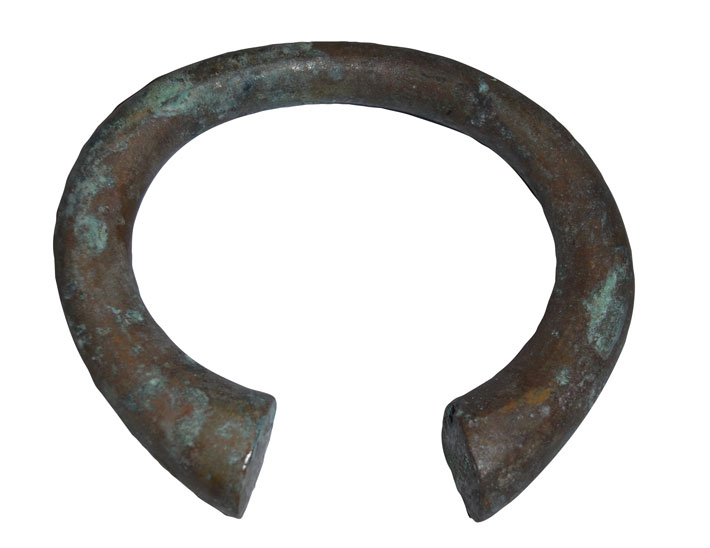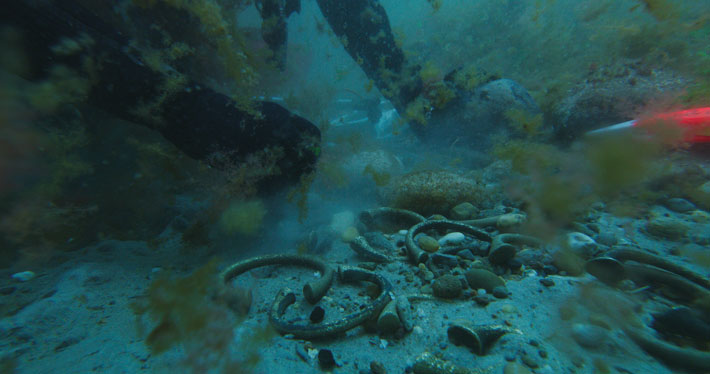The Benin Bronzes’ Secret Ingredient
November/December 2023
 Between the sixteenth and nineteenth centuries, the Edo people of the Kingdom of Benin, which controlled territory on the west coast of Africa that is now part of Nigeria, produced thousands of artworks that have come to be known as the Benin Bronzes. The works, which once decorated the kingdom’s royal palace, include personal ornaments, animal and human figurines, plaques that illustrate the kingdom’s history, and sculpted heads of its obas, or kings. A large quantity of the objects were looted during an 1897 British military expedition. Many of these are held in museums and private collections around the world and are the subject of ongoing repatriation efforts.
Between the sixteenth and nineteenth centuries, the Edo people of the Kingdom of Benin, which controlled territory on the west coast of Africa that is now part of Nigeria, produced thousands of artworks that have come to be known as the Benin Bronzes. The works, which once decorated the kingdom’s royal palace, include personal ornaments, animal and human figurines, plaques that illustrate the kingdom’s history, and sculpted heads of its obas, or kings. A large quantity of the objects were looted during an 1897 British military expedition. Many of these are held in museums and private collections around the world and are the subject of ongoing repatriation efforts.
Despite their name, the majority of the Benin Bronzes were actually made of brass, while others were crafted from materials such as ivory, coral, leather, and wood. The precise origin of the brass used to make the metal objects has long been a mystery. Brass is an alloy of copper and zinc. It often includes other elements as well, in particular lead, which is typically present in zinc ore. The ratio of different forms, or isotopes, of lead in a given sample of brass acts as a metallic fingerprint that can help identify its source. Research on the bronzes’ lead isotope ratios has produced tantalizing hints that the brass used to make them came from one specific area. For example, a study of 212 bronzes found that the lead isotope ratios of 113 of them were so similar that the zinc used to produce their brass had likely been sourced from a single mining deposit. The others differed only slightly and appeared to contain zinc sourced from nearby.
 It has long been suspected that the raw metal used to craft the Benin Bronzes came from manillas, horseshoe-shaped brass rings that were used as currency by Europeans to trade with West Africans, primarily for slaves, but also for goods such as ivory and spices. However, until recently, efforts to establish a scientific link between manillas and the artworks had come up short. “Metallurgists who analyzed manillas said they couldn’t be the source because the materials were too impure,” says Tobias Skowronek, a geochemist at the Technical University of Georg Agricola. He notes that the manillas in question were essentially alloys of copper and lead that included high levels of antimony and arsenic, elements that degrade the quality of the metal and result in cracking. The problem with these earlier studies, according to Skowronek, is that researchers were looking at the wrong types of manillas. “Their analysis focused only on materials from museums,” he says. “Most manillas in museums date to the twentieth or sometimes the nineteenth century, and don’t have anything to do with the material that was shipped during the period of the transatlantic slave trade.”
It has long been suspected that the raw metal used to craft the Benin Bronzes came from manillas, horseshoe-shaped brass rings that were used as currency by Europeans to trade with West Africans, primarily for slaves, but also for goods such as ivory and spices. However, until recently, efforts to establish a scientific link between manillas and the artworks had come up short. “Metallurgists who analyzed manillas said they couldn’t be the source because the materials were too impure,” says Tobias Skowronek, a geochemist at the Technical University of Georg Agricola. He notes that the manillas in question were essentially alloys of copper and lead that included high levels of antimony and arsenic, elements that degrade the quality of the metal and result in cracking. The problem with these earlier studies, according to Skowronek, is that researchers were looking at the wrong types of manillas. “Their analysis focused only on materials from museums,” he says. “Most manillas in museums date to the twentieth or sometimes the nineteenth century, and don’t have anything to do with the material that was shipped during the period of the transatlantic slave trade.”
 Now, a team led by Skowronek has analyzed a much broader range of manillas dating from the fifteenth to nineteenth centuries recovered from five shipwrecks and three land sites in West Africa, Western Europe, and off the East Coast of the United States. At least some of the ships from which the manillas were retrieved are believed to have plied the Triangle Trade. This involved trading manillas for West African slaves, who were brought to the Americas and sold. The ships would then return to Europe with goods such as sugar, cotton, and tobacco. Following a classification system developed by team member Rolf Denk of Eucoprimo, an E.U. organization that studies unusual forms of money, the researchers divided the manillas into three different types: early examples known as tacoais, which were traded by the Portuguese; a later style called Birmingham manillas, which appeared beginning in the eighteenth century; and a transitional type known as popo manillas.
Now, a team led by Skowronek has analyzed a much broader range of manillas dating from the fifteenth to nineteenth centuries recovered from five shipwrecks and three land sites in West Africa, Western Europe, and off the East Coast of the United States. At least some of the ships from which the manillas were retrieved are believed to have plied the Triangle Trade. This involved trading manillas for West African slaves, who were brought to the Americas and sold. The ships would then return to Europe with goods such as sugar, cotton, and tobacco. Following a classification system developed by team member Rolf Denk of Eucoprimo, an E.U. organization that studies unusual forms of money, the researchers divided the manillas into three different types: early examples known as tacoais, which were traded by the Portuguese; a later style called Birmingham manillas, which appeared beginning in the eighteenth century; and a transitional type known as popo manillas.
By studying the lead isotope ratios of each of these types of manilla, Skowronek’s team determined that the brass in the tacoais type was used to make the Benin Bronzes. They also found that the lead isotope ratios of the tacoais manillas were strikingly similar to those of lead-zinc ores mined in Germany’s Rhineland. Given that the process of smelting brass uses up a great deal of zinc, it generally took place near the zinc source. Thus, the researchers concluded, the tacoais manillas must have been produced in the Rhineland.
Skowronek believes the Edo metalsmiths who crafted the Benin Bronzes were undoubtedly aware of the superior qualities of the tacoais manillas and likely demanded them in trade. “These early Portuguese manillas are brass with a high lead content, an alloy that is easy to smelt,” he says. “If you want to make an art object like the Benin Bronzes, you need to have a metal that flows easily when melted, and the high lead content of these early manillas is responsible for that.”
Advertisement
IN THIS ISSUE
Digs & Discoveries
The Benin Bronzes’ Secret Ingredient
The Medusa of Mérida
The Queen’s Jewels
A Horse Is a Horse?
Sea God’s Sanctum
Child’s Play
A Stitch in Time
Trading on Their Looks
Imperial Datebook
Island Commander
Anglo-Saxon Style Marker
Off the Grid: Plum Bayou Mounds
Artifact
A tight-fisted deity
Advertisement

Recent Issues
-
 May/June 2024
May/June 2024
-
 March/April 2024
March/April 2024
-
 January/February 2024
January/February 2024
-
 November/December 2023
November/December 2023
-
 September/October 2023
September/October 2023
-
 July/August 2023
July/August 2023
-
 May/June 2023
May/June 2023
-
 March/April 2023
March/April 2023
-
 January/February 2023
January/February 2023
-
 November/December 2022
November/December 2022
-
 September/October 2022
September/October 2022
-
 July/August 2022
July/August 2022
-
 May/June 2022
May/June 2022
-
 March/April 2022
March/April 2022
-
 January/February 2022
January/February 2022
-
 November/December 2021
November/December 2021
-
 September/October 2021
September/October 2021
-
 July/August 2021
July/August 2021
-
 May/June 2021
May/June 2021
-
 March/April 2021
March/April 2021
-
 January/February 2021
January/February 2021
-
 November/December 2020
November/December 2020
-
 September/October 2020
September/October 2020
-
 July/August 2020
July/August 2020
-
 May/June 2020
May/June 2020
-
 March/April 2020
March/April 2020
-
 January/February 2020
January/February 2020
-
 November/December 2019
November/December 2019
-
 September/October 2019
September/October 2019
-
 July/August 2019
July/August 2019
-
 May/June 2019
May/June 2019
-
 March/April 2019
March/April 2019
-
 January/February 2019
January/February 2019
-
 November/December 2018
November/December 2018
-
 September/October 2018
September/October 2018
-
 July/August 2018
July/August 2018
-
 May/June 2018
May/June 2018
-
 March/April 2018
March/April 2018
-
 January/February 2018
January/February 2018
-
 November/December 2017
November/December 2017
-
 September/October 2017
September/October 2017
-
 July/August 2017
July/August 2017
-
 May/June 2017
May/June 2017
-
 March/April 2017
March/April 2017
-
 January/February 2017
January/February 2017
-
 November/December 2016
November/December 2016
-
 September/October 2016
September/October 2016
-
 July/August 2016
July/August 2016
-
 May/June 2016
May/June 2016
-
 March/April 2016
March/April 2016
-
 January/February 2016
January/February 2016
-
 November/December 2015
November/December 2015
-
 September/October 2015
September/October 2015
-
 July/August 2015
July/August 2015
-
 May/June 2015
May/June 2015
-
 March/April 2015
March/April 2015
-
 January/February 2015
January/February 2015
-
 November/December 2014
November/December 2014
-
 September/October 2014
September/October 2014
-
 July/August 2014
July/August 2014
-
 May/June 2014
May/June 2014
-
 March/April 2014
March/April 2014
-
 January/February 2014
January/February 2014
-
 November/December 2013
November/December 2013
-
 September/October 2013
September/October 2013
-
 July/August 2013
July/August 2013
-
 May/June 2013
May/June 2013
-
 March/April 2013
March/April 2013
-
 January/February 2013
January/February 2013
-
 November/December 2012
November/December 2012
-
 September/October 2012
September/October 2012
-
 July/August 2012
July/August 2012
-
 May/June 2012
May/June 2012
-
 March/April 2012
March/April 2012
-
 January/February 2012
January/February 2012
-
 November/December 2011
November/December 2011
-
 September/October 2011
September/October 2011
-
 July/August 2011
July/August 2011
-
 May/June 2011
May/June 2011
-
 March/April 2011
March/April 2011
-
 January/February 2011
January/February 2011
Advertisement





